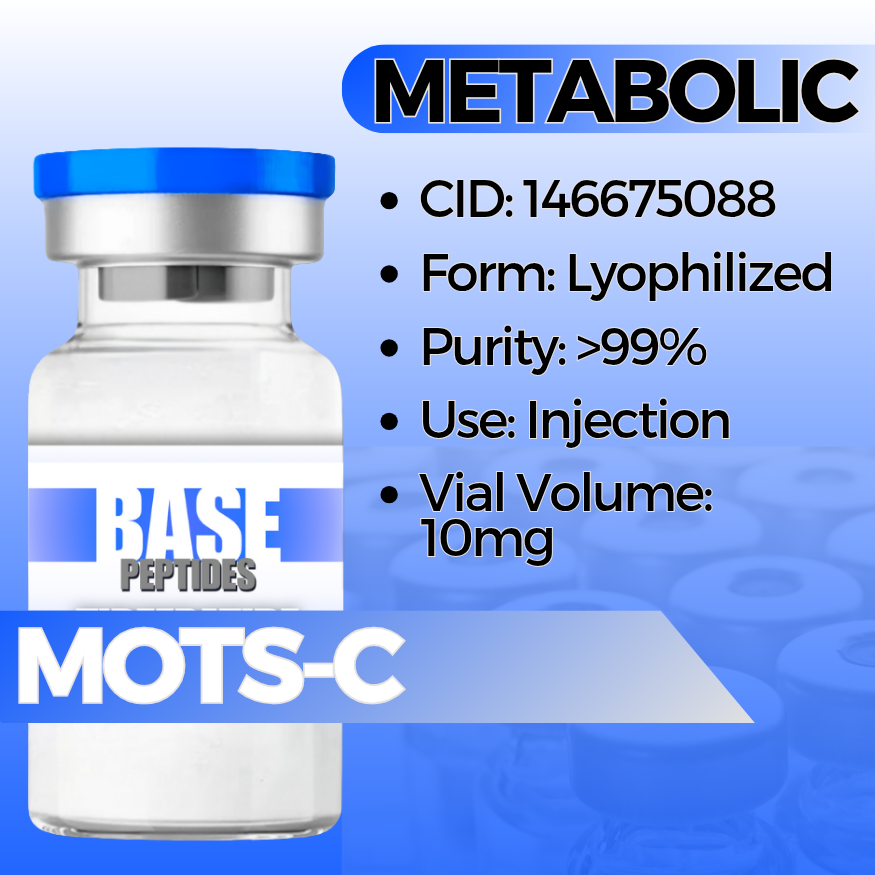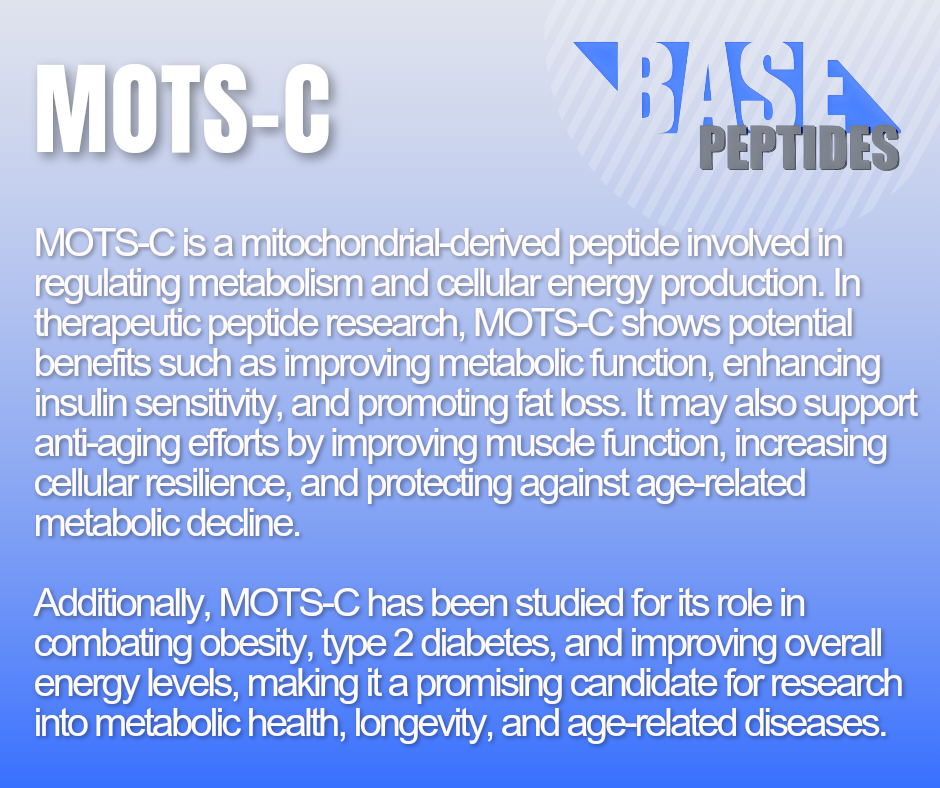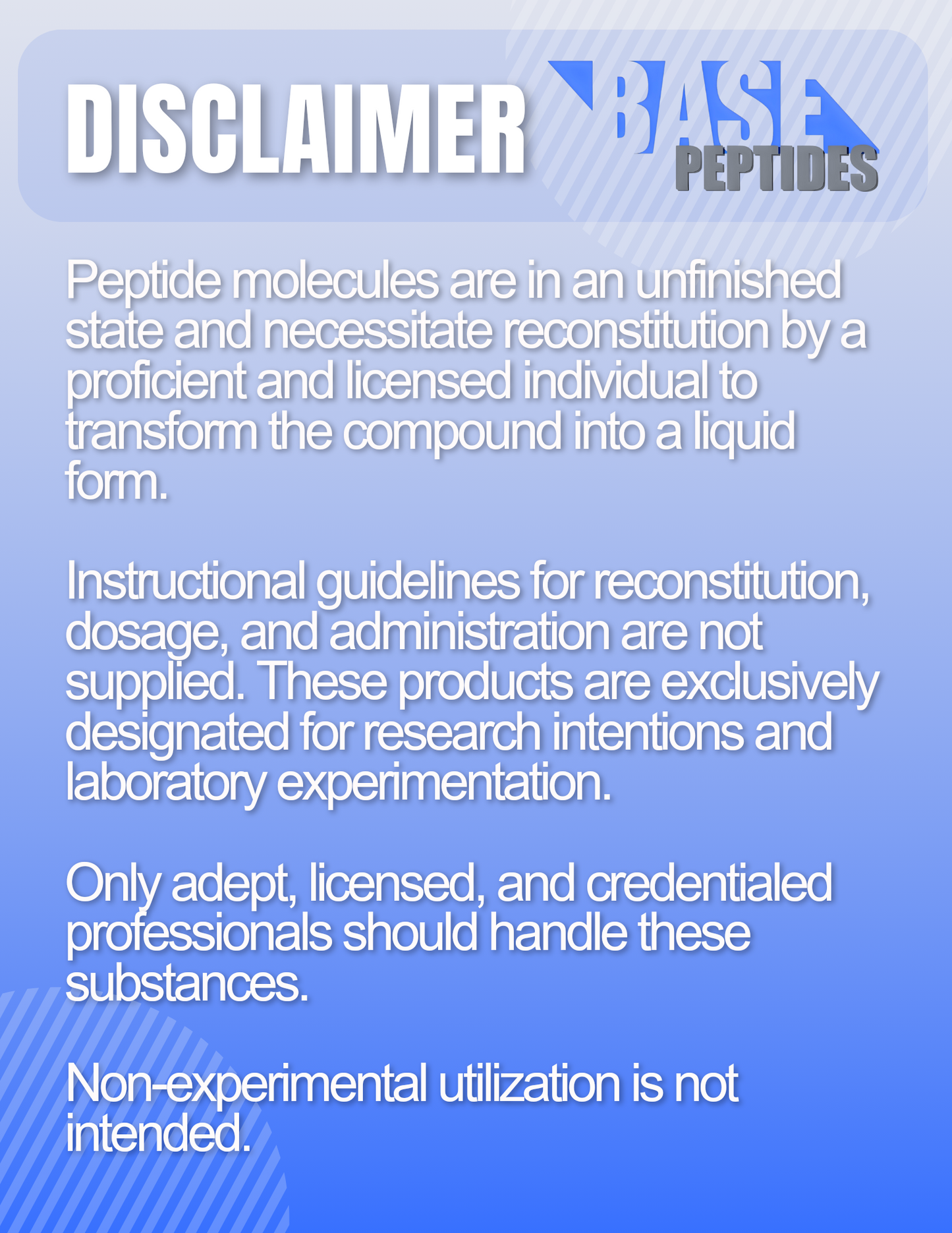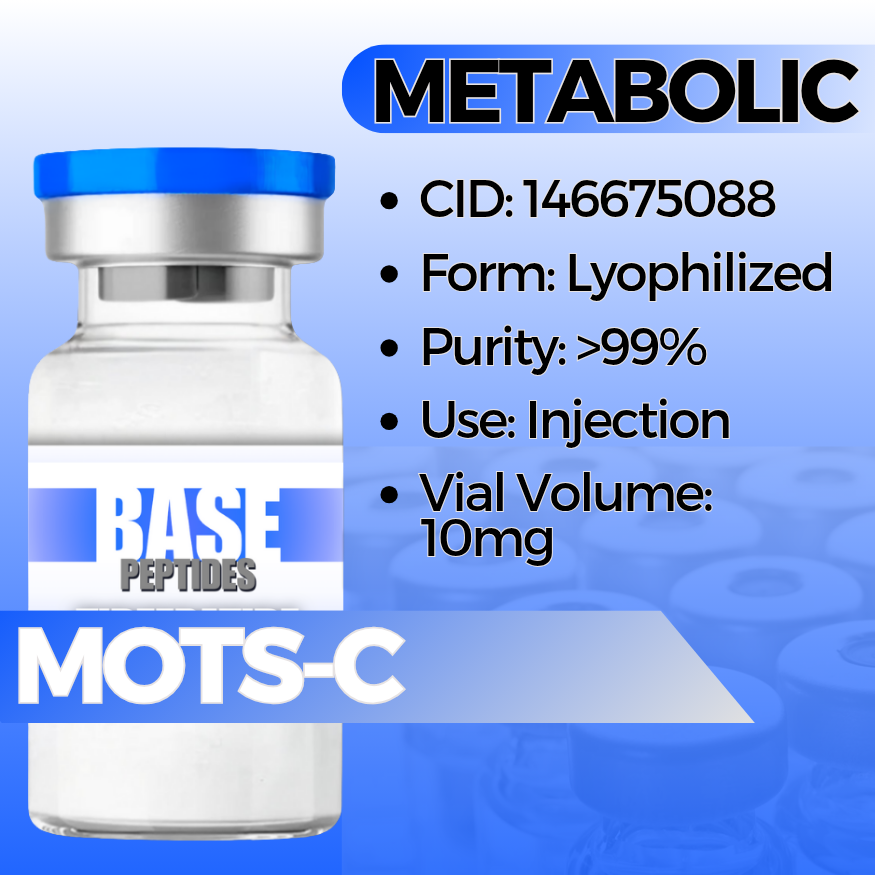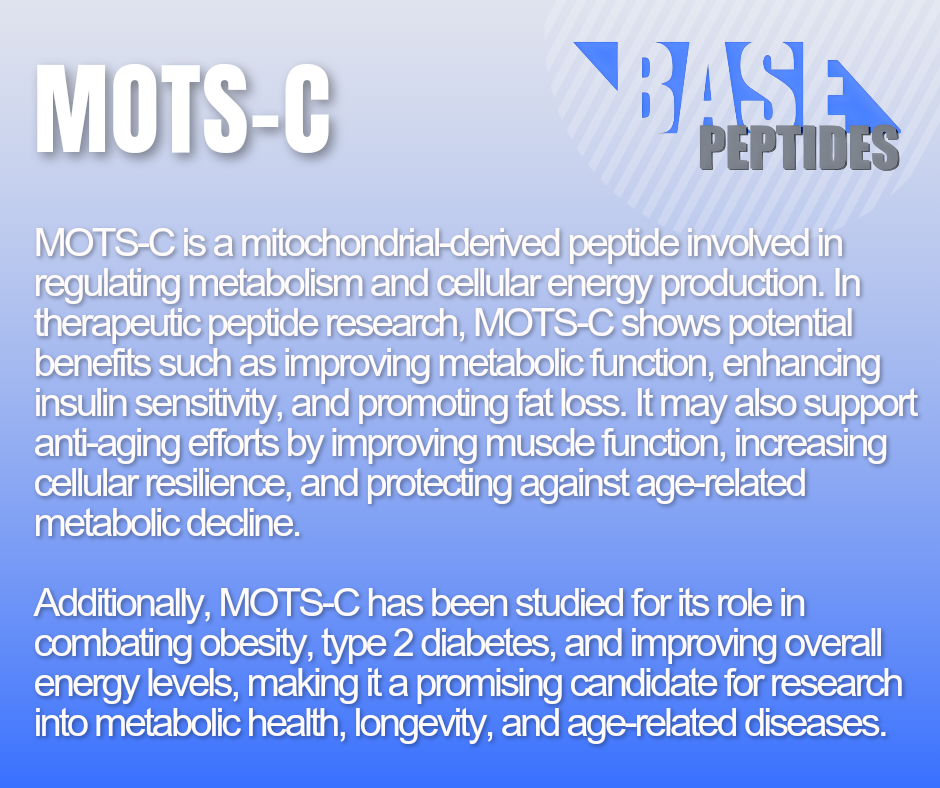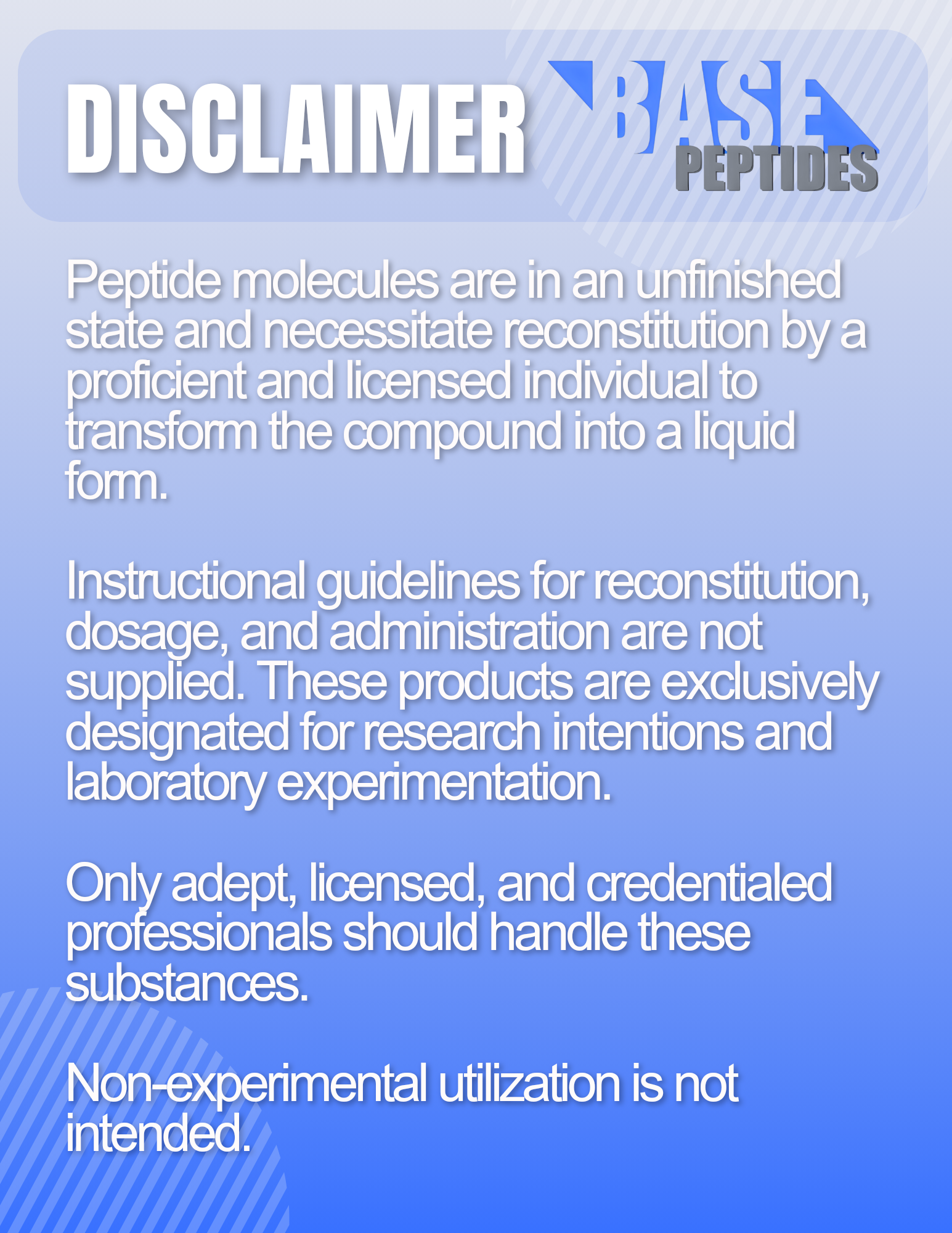MOTS-C
MOTS-C
Base Peptides are intended for licensed medical professionals and experienced researchers. Reconstitution required. Dosing and use instructions are not provided.
Couldn't load pickup availability
MOTS-c — Mitochondria-Derived Peptide (16 aa)
MOTS-c is a short peptide encoded in the mitochondrial genome (within the 12S rRNA region). In research, it’s used to explore cellular energy sensing, stress adaptation, and insulin sensitivity with a focus on AMPK-linked pathways.
- CAS: 1627580-64-6
- PubChem CID: 146675088
- Formula / MW: C101H152N28O22S2 · ≈ 2174.6 Da
- Sequence (human): Met-Arg-Trp-Gln-Glu-Met-Gly-Tyr-Ile-Phe-Tyr-Pro-Arg-Lys-Leu-Arg (MRWQEMGYIFYPRKLR)
- Origin: Encoded by mitochondrial DNA (not nuclear DNA)
- MOTS-c helps cells sense low-energy states and activates AMPK, a master regulator of energy balance.
- It’s linked to the folate–AICAR–AMPK pathway, which increases cellular glucose uptake and supports metabolic homeostasis.
- Under stress (exercise, low nutrients), MOTS-c can move to the nucleus and influence expression of stress-response genes.
- To study insulin sensitivity, glucose handling, and mitochondrial stress signaling.
- To model exercise-mimetic effects and energy-management pathways.
- To explore healthy aging hypotheses tied to cellular stress resistance.
Key Studies — What Was Tested, What Changed, Why It Matters
Metabolic homeostasis & insulin sensitivity (foundational work)
- What was tested: MOTS-c exposure in cell and animal models tracking glucose uptake, insulin response, and weight trends.
- What changed: Improved insulin sensitivity, better glucose tolerance, and protection against diet-induced weight gain in rodent models.
- Why it matters: Establishes MOTS-c as a tool for studying AMPK-centric energy regulation rather than direct hormone replacement.
Stress-response gene programs (nuclear translocation)
- What was tested: Cellular stress conditions (e.g., low glucose) and MOTS-c localization.
- What changed: MOTS-c translocated to the nucleus and engaged NRF2/ARE-linked antioxidant and stress-adaptation genes.
- Why it matters: Shows how a mitochondrial peptide can coordinate nuclear gene expression during stress, bridging mitochondria–nucleus communication.
Human-relevance signals (observational)
- What was tested: Associations between circulating or tissue MOTS-c and markers like insulin resistance, fat mass, and age.
- What changed: Reports link MOTS-c levels to metabolic health and age-related trends (direction and magnitude vary by cohort).
- Why it matters: Guides sample timing and cohort selection in translational designs; still requires controlled interventional work for causality.
Potential Research Applications
Metabolic Models
- Glucose uptake and insulin-signaling assays
- AMPK activation and downstream readouts
Exercise & Stress Biology
- Exercise-mimetic pathways and mitochondrial stress tests
- NRF2/ARE antioxidant-gene programs
Healthy Aging Hypotheses
- Cellular resilience and oxidative-stress models
- Adiposity distribution and metabolic flexibility
Synergistic Peptides (for Study Design)
Semaglutide (GLP-1)
- Why pair: Incretin pathway for appetite/glucose control complements MOTS-c’s AMPK-centric energy signaling.
- Angle: Combined readouts: food intake, glycemia, and AMPK markers.
Tirzepatide (GLP-1 + GIP)
- Why pair: Dual incretin model to compare single vs dual hormone signaling layered on AMPK activation.
- Angle: Insulin sensitivity, lipid panels, and body-composition trends.
AOD-9604 (hGH fragment 176–191)
- Why pair: Focuses on fat-metabolism pathways; useful alongside AMPK signaling.
- Angle: Lipolysis + glucose-uptake panels with imaging-based adiposity endpoints.
Design Notes
- Pre-define fasting/feeding windows—metabolic endpoints are timing-sensitive.
- Capture both acute (minutes–hours) AMPK readouts and chronic (weeks) composition markers.
- Document vehicle, pH, light, and freeze–thaw cycles; small handling shifts can move results.
Known Concerns (Context)
- Assay design: AMPK signaling is highly context-dependent; standardize stressors, temperature, and nutrient media.
- Translation: Strong preclinical signals exist; human-interventional data are still developing across indications.
- General: Sold for laboratory research use only; not for human/medical/veterinary use.
Follow institutional SOPs for metabolic-pathway peptides and mitochondrial-stress assays.
Specifications & Handling
- Form: Lyophilized powder (lot-coded)
- Purity: ≥ 99% (HPLC/MS verified)
- Storage: ≤ −20 °C; protect from light/moisture
- In solution: Aliquot promptly; avoid repeat freeze–thaw
- Additives: None unless specified per lot
- Packaging: Tamper-evident; research-only labeling
Regulatory & Use Notice
Sold for laboratory research use only. Not for human consumption, medical, or veterinary use. No human-use instructions are provided. Buyer is responsible for safe handling and regulatory compliance.
MOTS-c Peptide Research | Mitochondria-Derived Peptide | AMPK, Insulin Sensitivity & Stress-Response Studies
